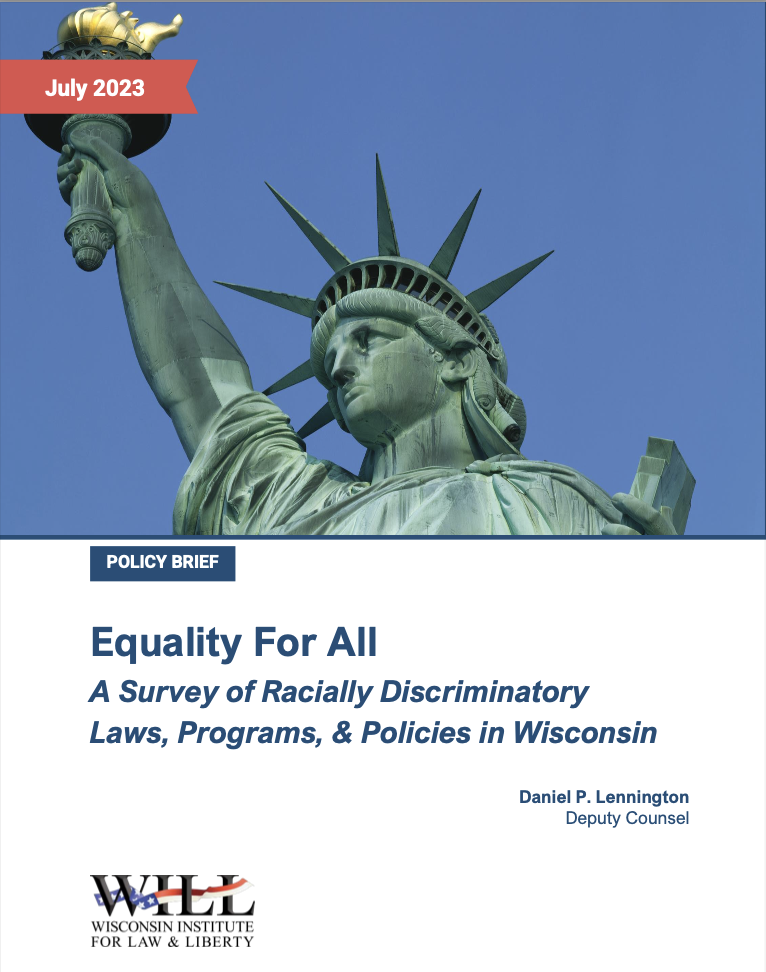A Survey of Racially Discriminatory Laws, Programs, and Policies in Wisconsin
Executive Summary
The United States Supreme Court recently decided that colleges and universities may no longer use race as a factor in admissions. This practice, commonly called “affirmative action,” was declared unconstitutional in Students for Fair Admissions v. Harvard.
The decision, however, has much broader implications: it confirms that our Constitution is “colorblind” and that governments may not treat their citizens differently based on race. The Court explained that the Constitution demands “absolute equality of all citizens.” Exceptions to this rule are exceedingly rare, reserved for situations like preserving order in a prison, or to remedy the government’s own past intentional discrimination. Governments may not use race to cure “societal discrimination,” “systemic racism,” or to advance modern-day notions of “diversity” and “equity.” In the Court’s words, “eliminating racial discrimination means eliminating all racial discrimination.”
Additionally, the Court’s broad language implicates practices outside the bounds of the Constitution—namely, private affirmative action programs or “diversity, equity, and inclusion” initiatives. Harvard, after all, is a private college and its program was evaluated under the law governing programs receiving federal financial assistance (Title VI). The Court concluded that this statute contains the same protections against discrimination as the Constitution’s Equal Protection Clause, and that Harvard’s use of race in admitting students was unlawful under that statute. Title VI contains language that is identical to or functionally similar to a variety of federal laws, including, for example, the statute prohibiting discrimination by private businesses (Title VII). The Students for Fair Admission decision, therefore, has the potential to upend not only government-sanctioned discrimination, but even race-based private conduct pursued in the name of “diversity, equity, and inclusion.” Put simply, the decision calls into question a whole panoply of race-based programs in the public and private sectors.
So what does this mean for Wisconsin? Our state and local governments have several race-based laws and programs that are likely unconstitutional. While these programs were always unconstitutional, Students for Fair Admissions underscores their infirmity. These laws and programs have persisted for two basic reasons: (1) no court has yet struck them down and (2) politicians have so far lacked the resolve to repeal them. With this new decision, however, that may very well change. In the face of the Court’s clear and emphatic language, policymakers may now be emboldened to embark on a “colorblind” course to ensure our laws are neutral and that race is never used as a “negative” or “stereotype,” in the words of the Supreme Court. Those that are not repealed may eventually be the subject of litigation.
Below is a sample of several Wisconsin state laws and programs that now appear to be unconstitutional and can no longer be defended under current law. While this brief is limited to discussing Wisconsin law, no doubt most other states have similar indefensible laws.
State Laws – Race Discrimination
- Race-based scholarships. Wisconsin maintains two scholarships for higher education students that discriminate based on race. Whites, Middle Eastern students, and most Asian students may not receive a scholarship because of their race. See Stat. §§ 36.34, 39.44. WILL is suing over one of these scholarships, and the case is pending.
- Race-based teacher loans. Wisconsin offers loans for teachers based on race. Although aimed at “minority” teachers, certain races are arbitrarily excluded, like teachers whose ancestors are from the Middle East. Wis. Stat. § 40.
- Racial preferences in state contracting. Wisconsin state law offers numerous benefits to businesses, including special access to government contracting, based on race. Eleven state laws employ these race-based preferences. Wis. Stat. § 287. The state carries this out through an elaborate, race-based Minority Business Certification Program.
- Health equity grant program. The Department of Health Services may award grants to improve health outcomes, but only for certain racial groups. State law includes an archaic definition of “Asian,” using something called “Wallace’s Line,” which has been itself critiqued as resulting in “colonial oppression and racial prejudice.” The upshot is that DHS’s program excludes most Asians (such as individuals with ancestors from China, India, Pakistan, Philippines, & Japan) from the definition. Wis. Stat. § 20.
- Race-based drug treatment. State law contains a grant program for alcohol and drug abuse, but only for “Hispanics and Black Americans.” The law does not explain why it is so limited. See Stat. § 46.975. A separate “treatment alternative program,” Wis. Stat. § 46.65, also uses racial preferences.
- Busing of students. Busing seems like something from a bygone era. But in Wisconsin it is current law. State law gives money to schools that bus certain students based on race. Wisconsin offers no justification for why this exists or what “problems” it solves. Wis Stat. § 85.
-
Wisconsin Council on Affirmative Action. This legislatively created council supports “affirmative action” throughout the state. To the extent that such plans benefit or penalize employees based on race, the council’s work would be unconstitutional. Moreover, the explicit racial quotas for Council members are likewise unconstitutional. Wis. Stat. §
.
Agencies – Race-Based State Programs
- UW Faculty Diversity Initiative. UW discriminates based on race when hiring professors. It is called the “Target of Opportunity” program.
- UW Racially Segregated Residence Halls. UW offers multiple opportunities for students to segregate themselves by race in student dorms.
- UW BIPOC-affirming spaces. UW offers several “affirming spaces” limited by race; non-preferred races are instructed to “approach these spaces with care.”
- UW BIPOC Coalition Energy Assistance. A UW student group offers $75 in “energy assistance” but cautions: “we will be prioritizing people who identify as BIPOC (Black, Indigenous, Person of Color) as well as people who identify as queer and/or disabled.”
- UW Green Bay “BIPOC RISE” Program and Scholarship. UW-Green Bay limits access to a mentoring group and a scholarship based on race.
- UW Milwaukee Diversity Internship Program. UW-Milwaukee offers an internship limited to benefitting only certain races.
- Wisconsin Partnership Program. UW’s School of Medicine runs a “health equity” grant program that funds groups targeting certain racial minorities.
- WEDC Diverse Business Development Grants. Economic development grants are available, but only for certain races.
- DWD Workforce Equity Grants. DWD offers an “equity” grant, but the program is based on benefitting certain races.
- DHS Minority Health Grant Program. DHS offers funding for certain organizations that serve certain racial populations across the state.
- DOA Diverse Investment Grant Program, Supplier Diversity Program, Diverse Business Grants. DOA runs at least three programs directed at helping Wisconsin businesses, but only businesses owned by certain preferred races.
- DOT Programs. WisDOT Supplier Diversity Program and WisDOT Disadvantaged Business Program offer help to only certain races.
- State Mandated Affirmative Action Plans. Some state agencies require “affirmative action plans” for certainprograms. Any use of race, however, to advantage or disadvantage an employee would likely be illegal.
- Technical College Board Quotas. Under Wisconsin law, technical college boards must justify their racial makeup through a system of quotas.
- Agency Equity and Inclusion Plans. All state agencies must have “equity” plans, and several call for explicit race discrimination against whites and other disfavored groups. For example:
-
- DOR plans to hire two “diverse” interns, five auditors from “diverse populations,” employ racial quotas on hiring panels, and create diversity “awards and recognition.”
- DOC has created “affinity groups” and “safe spaces” for certain groups and targeted training to “employing units with higher percentage of diverse employees.”
- DHS employs specific racial quotas for hiring panels and a “mentorship/leadership program” based on race. DHS promised that by 2023 it will increase the number of “marginalized” staff hired or promoted into open or available leadership positions by 15%.
- DOT assigns employees to “recruitment and outreach efforts” based on race and assigns interview panels based on race. DOT also employs goals to increase minority hiring and advancement.
- DOJ promises to hire more employees and interns based on race, use quotas on hiring panels, and to “establish DEI as a priority and value at all levels of the organization.” DOJ also says it will identify and fix “wage gaps” and require “interview questions related to DEI” during the hiring process. DOJ specifically claims it will “increase advancement rates” for minorities.
- DNR advances a policy called “targeted diversity hiring.” It will also create a “new DNR fellowship program” for “people of color.”

Equality For All: A Survey of Racially Discriminatory Laws and Policies in Wisconsin
Policy Brief by Dan Lennington
